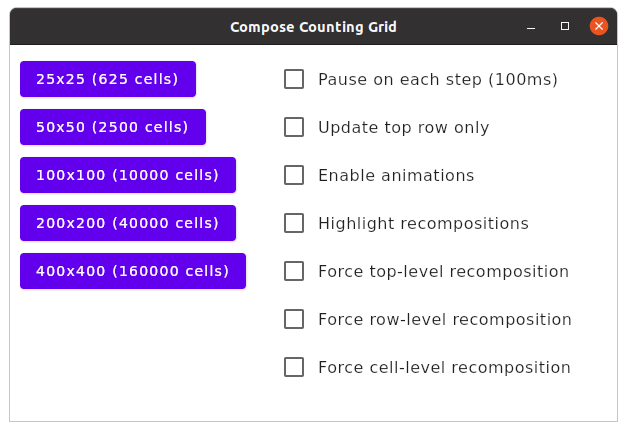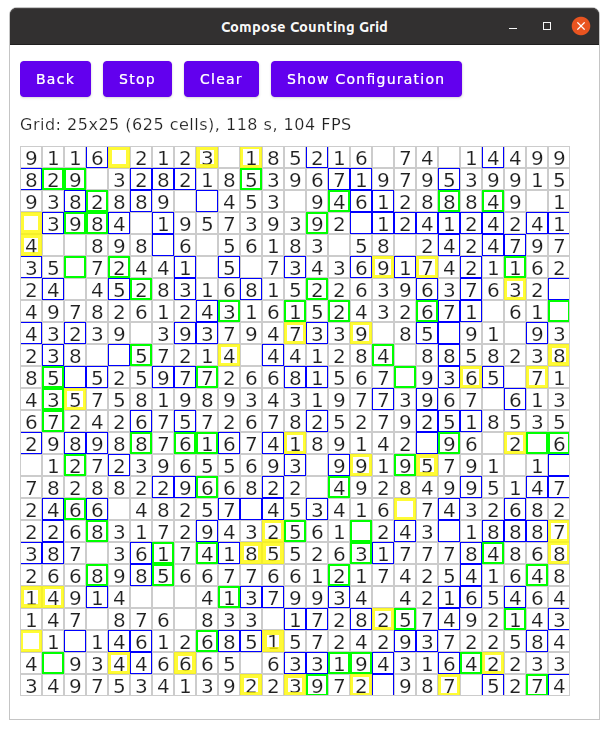A simple application to check Compose for Desktop and Compose for Web (Canvas) drawing speeds when drawing grids (or tables) with larger numbers of cells.
Implementation differences:
- The desktop application uses a window-sized canvas. Compose scrollbars appear if necessary.
- The web application uses a content-sized (window) canvas. The browser's scrollbars appear if necessary.
-
This animated GIF
⚠️ not suitable for people with photosensitive epilepsy⚠️ demonstrates increasing FPS as the window shrinks: Animation with high-frequency updates.This effect appears with the desktop application, not the web application.
Given a grid of cells: Choose a random cell. Increase its single-digit count. Repeat.
Unless pausing is enabled, updates will be drawn as fast as possible. The desktop application will even go beyond your display's vsync frequency (which Compose/Skia normally would not do, as it makes no sense other than to check the speed).
JVM desktop application: ./gradlew run
Browser application: ./gradlew frontendJsBrowserProductionRun (requires some patience for bundles to load)
Currently,
frontendJsBrowserDevelopmentRuncannot be used as the development bundle does not build due to JetBrains/compose-jb#2255.
- Try everything without animations first.
- Resize the window so that only the top row of counters is visible.
- Highlight re-compositions.
- Toggle "Force top-level recomposition".
- This application does not simulate any real-world scenario as it uses a very simple layout with fixed-size cells.
- Compose for Web on Canvas is at an experimental stage. This application uses funky tricks to fit the canvas to its content size.
Observations:
- Larger grids are slower.
- Grids with fewer cells containing text are faster (choose top-row updates only, then clear the grid).
Note that empty cells don't have a
Textcomponent. - Grids with more cells scrolled out of view (applies to desktop only) are faster.
- Top- or row-level layout and recomposition accounts for about 10% of total performance (try forcing top-level and/or row-level recompositions, check the profiler's flame graph). In these scenarios, redrawing dominates performance.
- Cell-level recomposition is expensive. On desktop, it cuts the frame rate by 50% (25x25 grid) or even by 70% (50x50 grid), and makes the profiler's flame graph show significant recomposition and layout activity. Redrawing is still relevant, but less so. On the browser, the frame rate drops by 80% (25x25 grid) or more.
Conclusions:
- Currently, it appears that the entire (window) canvas is redrawn on every frame. Once JetBrains/skiko#53 is fixed and only updated parts are redrawn, expect significant performance increases.
- Drawing time increases with the number of visible layout nodes.
- Still, Compose for Desktop seems pretty fast.
- Compose for Web/Canvas is significantly slower than desktop (I have seen roughly a factor of 3), but it would also use just 10% for layout and top/row-level recomposition. Depending on the use case, even at this early stage Web/Canvas could still be fast enough.
- It pays to avoid recompositions which affect large numbers of composables.
- Added options to force row-level and cell-level recompositions. Revised conclusions regarding recomposition and layout impact.
- Improved UI responsiveness when toggling options for recomposition highlighting and animations.
- Redesigned Web/Canvas integration thanks to @langara

